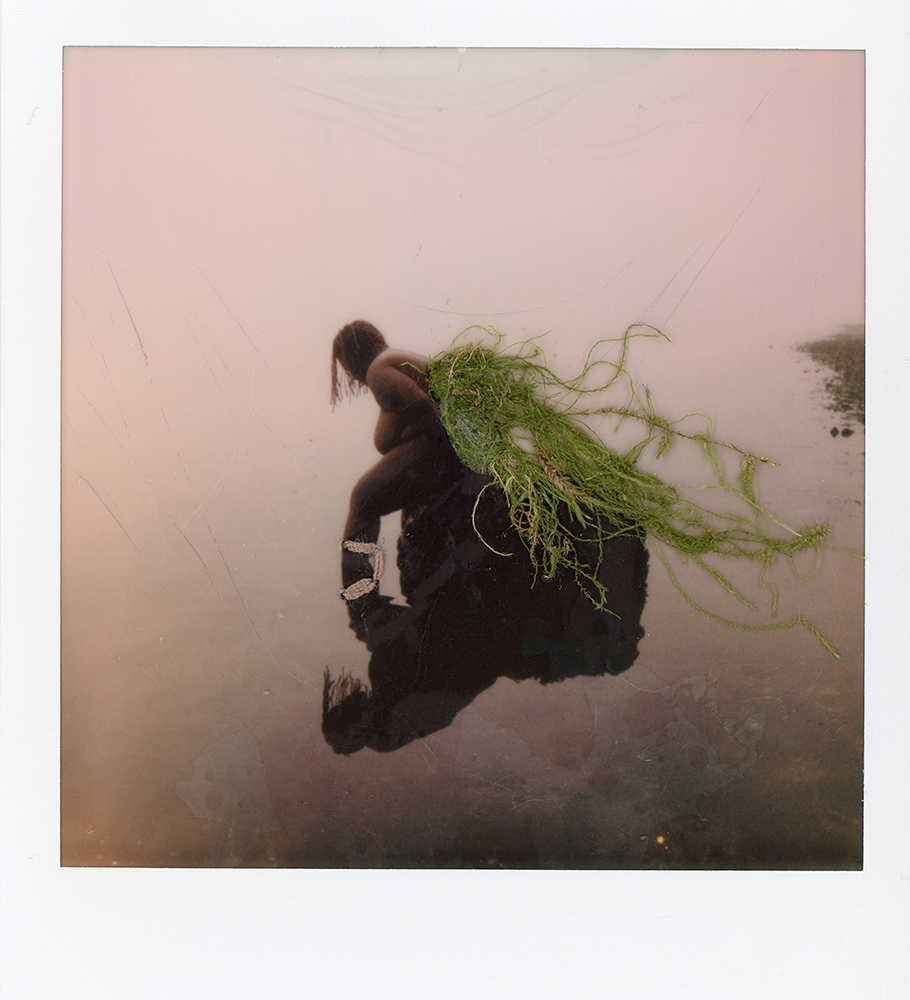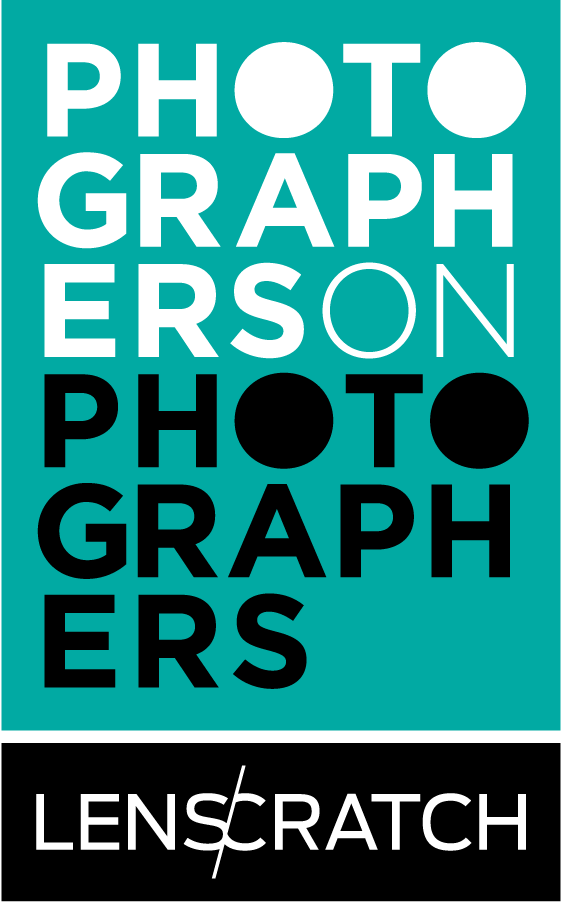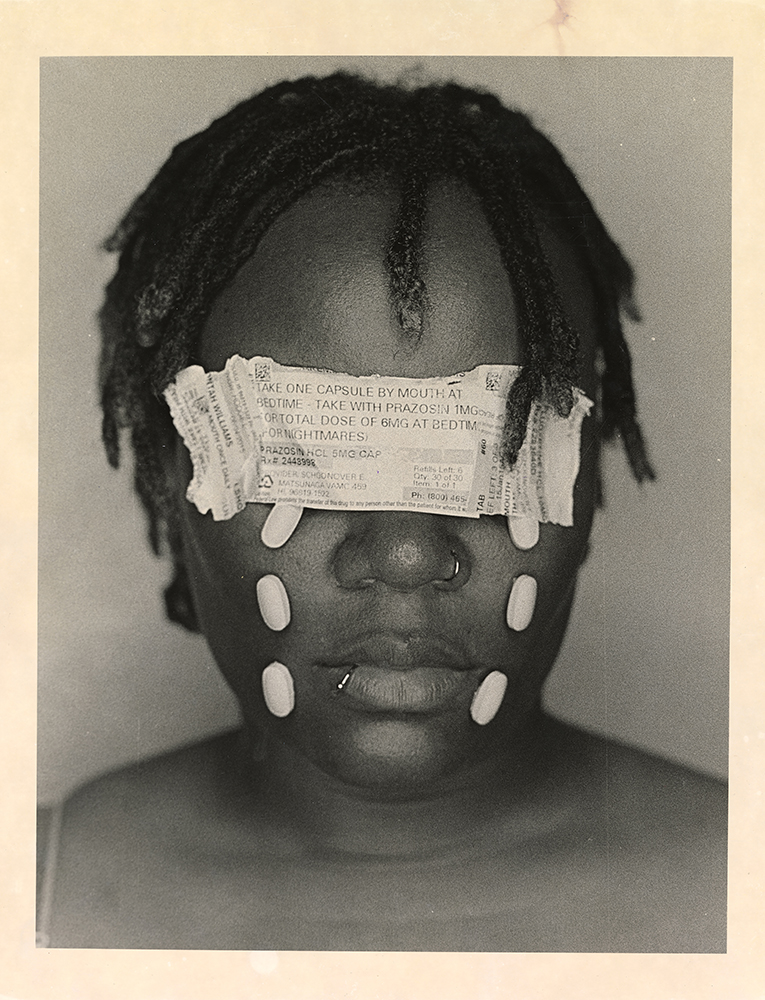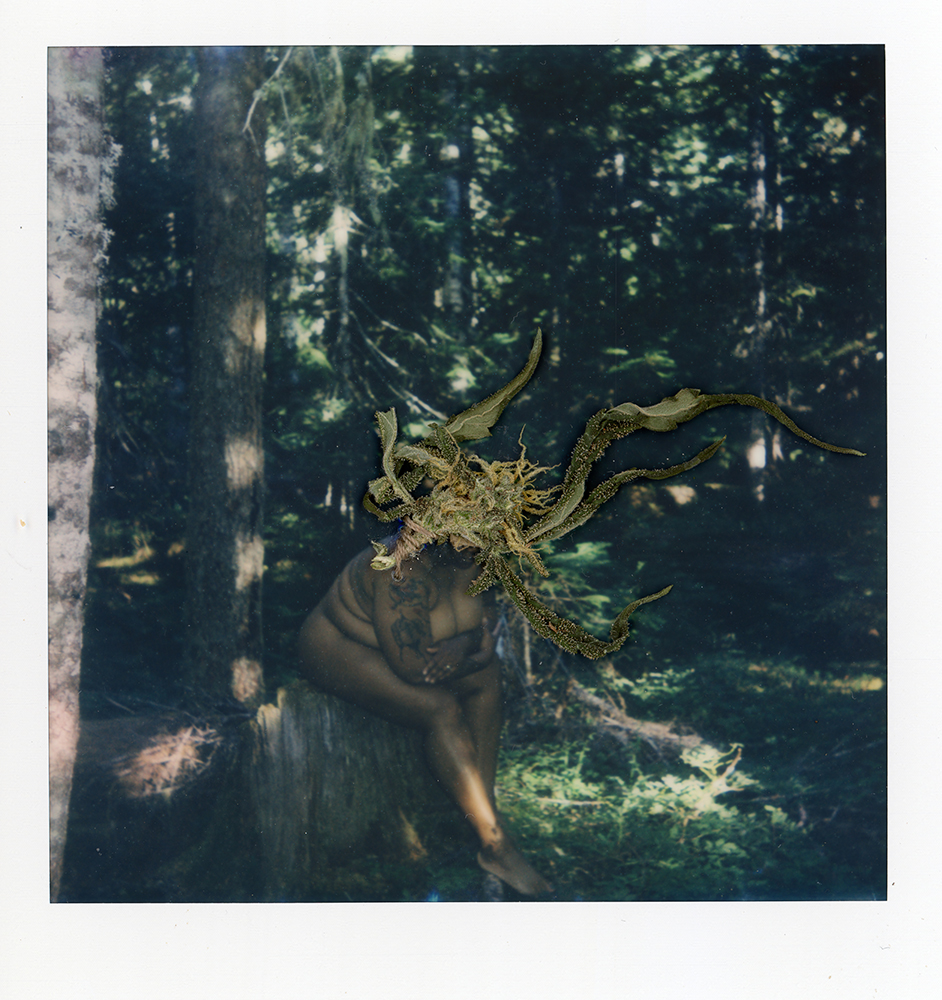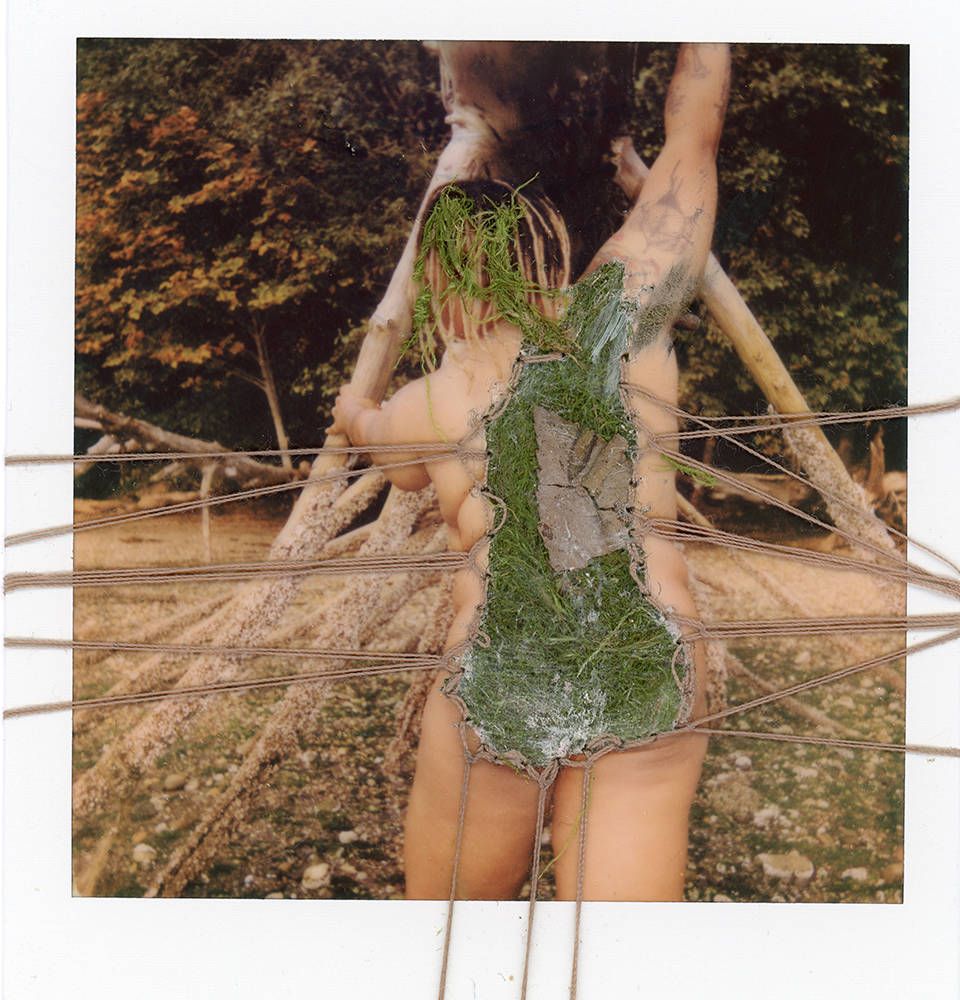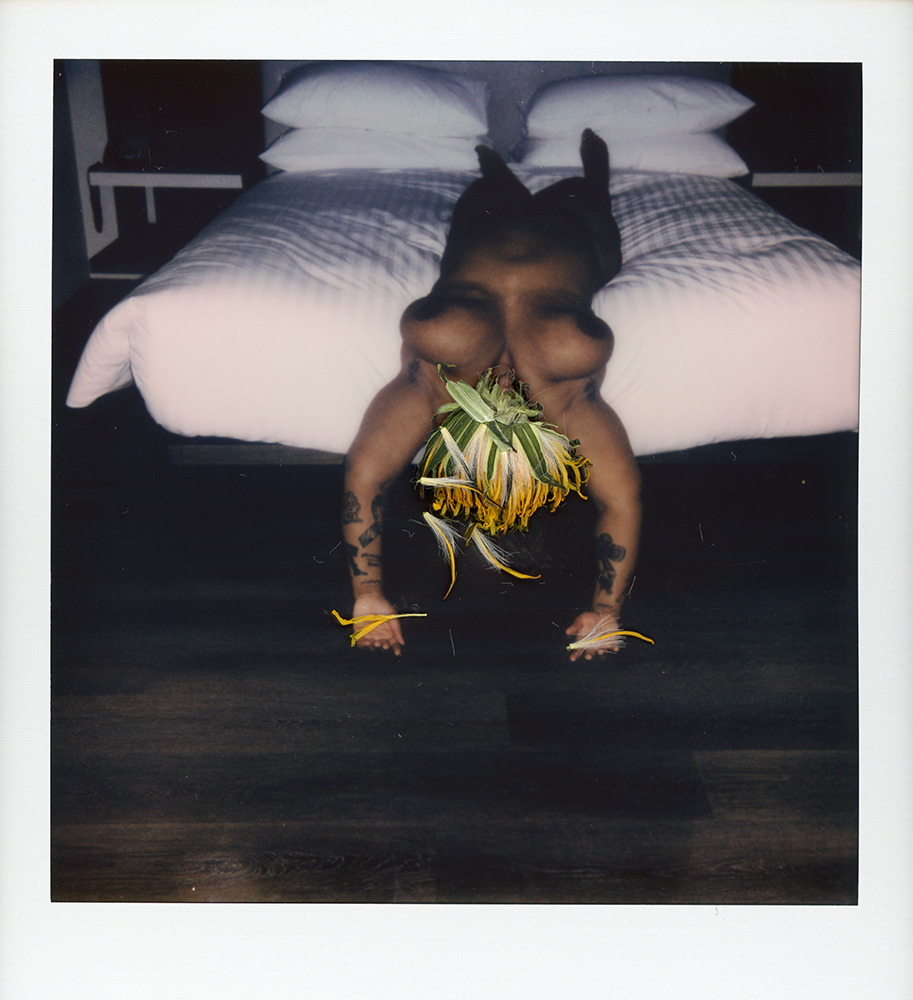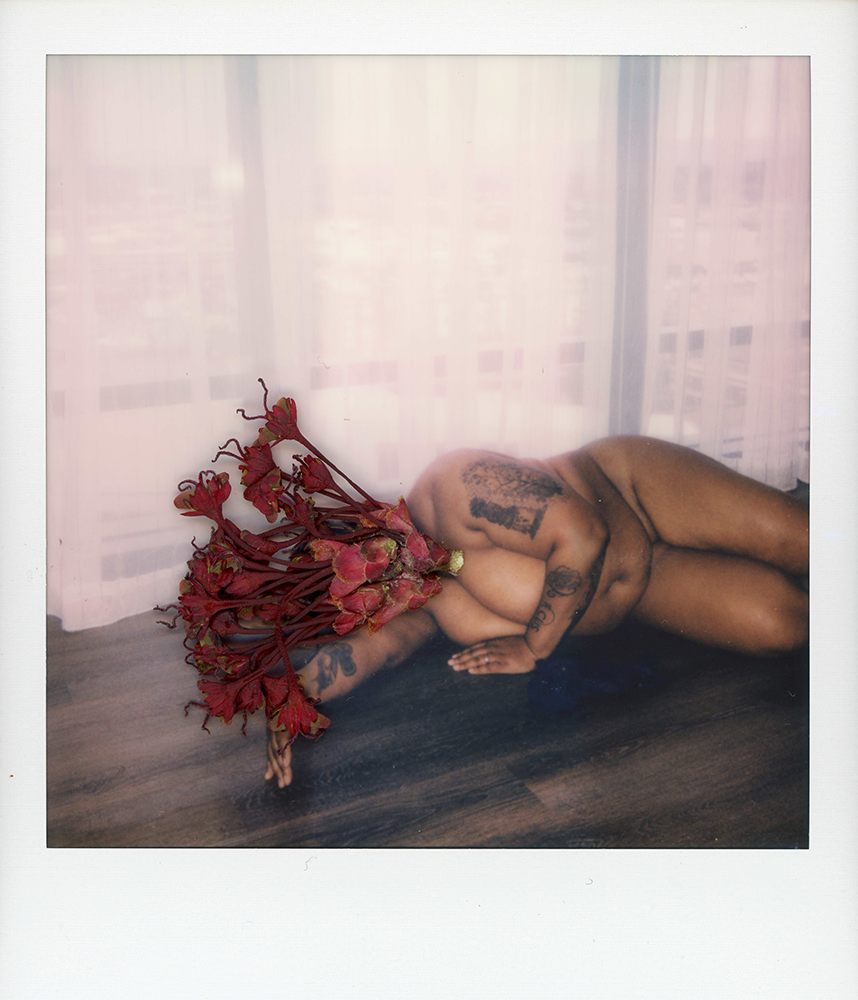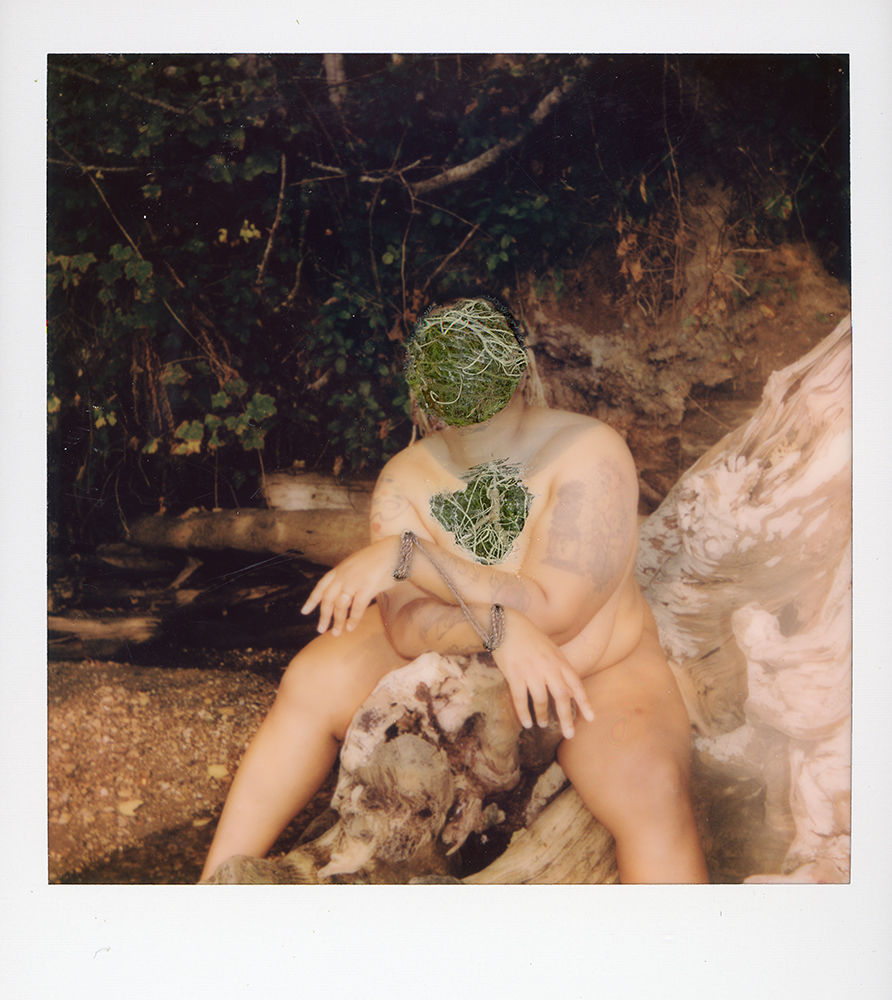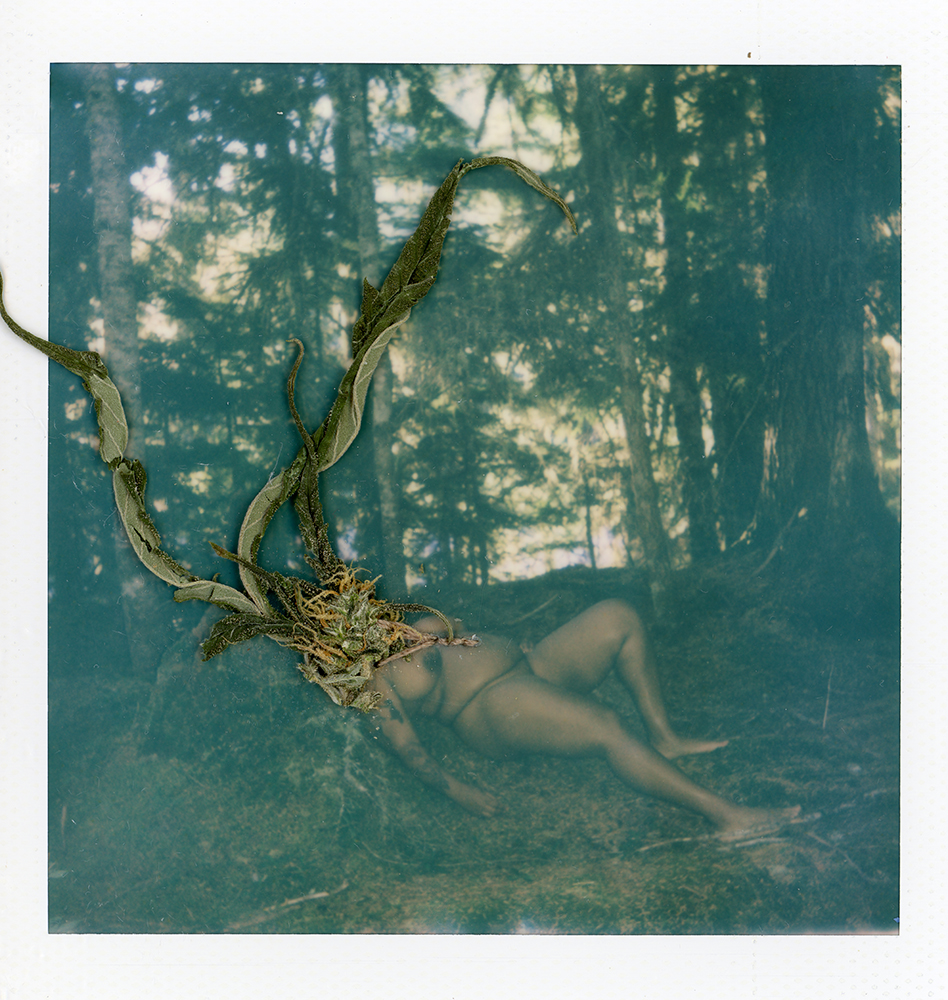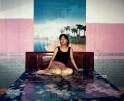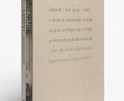Photographers on Photographers Megan Bent in Conversation with Nakemiah Williams
Image: A Polaroid of Nakemiah sitting on a rock in the middle of water. She is Black woman with shoulder length braided hair and is nude. We see her from the side and she is looking down into the water. Her body and the rock are reflected in the water’s surface. Coming out of her back are long bright green tendrils of moss. There are stitching marks in the Polaroid at her ankles and calves.
Nakemiah Williams is a Hawaii-based artist who studied Art at the University of Hawai’i at Manoa. She completed her Bachelor’s degree in Fine Arts in the spring of 2020. It was while she took a digital imaging class during undergrad that Nakemiah realized that she was able to expand her passion for art beyond film photography. During her undergraduate career she earned the Outstanding Undergraduate Digital Award. Throughout the last year, Nakemiah chose to focus on a particular technique which involves destroying polaroids by burning, cooking, ripping, or scratching the image itself. She then scans the polaroids to make large prints, showing fine details of the damage. This style helps her to outwardly express how she has felt while dealing with trauma from being in the Army. She hopes to reflect these emotions and feelings through her work. Additionally, in 2018 she had a few of her coffee-developed prints shown in an exhibition called “No Shame in My Game” in New Jersey, which later received an Outstanding Undergraduate Award in Film Photography. In 2019 she received an Outstanding Undergraduate award for Digital Imaging after she got into a group exhibition “Time Zero and Beyond: Instant Photography” in Rhode Island is when she had a few of her first polaroids from the series, “The Negative”. Throughout 2020, Nakemiah has had her artwork displayed in different areas including the “Person/Persona” Exhibition, ARS Cafe, Honolulu HI, the Honolulu Printmakers 92nd Annual Exhibition (Student Award for Excellence) and the Annual Girl Group Show, Treehouse, Honolulu, HI. Up Close & Personal Exhibition, Poughkeepsie, NY 2021, In The Negative Exhibition, Seattle, WA 2022 and Macromorphōsis Exhibition, Brant Gallery at MassArt, Boston, Massachusetts 2023. Furthermore, her art has been featured in the FLUX Hawaii Magazine in 2020. Currently Nakemiah lives in Washington State but hopes to continue her artwork and have it displayed at different exhibitions. She continues to commit her artwork toward showing both an inner and outer expression of herself.
Instagram: @nakemiahwilliams.nw
Please note: this interview took place in late December 2023
Megan: Would you please tell us a little bit about yourself?
Nakemiah: My name is Nakemiah (Kiki) Williams. I am a Polaroid artist, retired veteran, and a sexual assault survivor. I’ve also been married for 12 years to my husband who is actively in the military. For a bit more context about myself, I wanted to highlight those three things about myself because they heavily influenced who I am as an artist and what I try to communicate through my work. While in Hawaii, I was diagnosed with PTSD and anxiety, so I was prescribed medications to help with my diagnosis, but I experienced medical complications, causing me to lose bodily control in the right side of my body and also resulted in speech problems. Because of this, I was sent to an inpatient rehabilitation center in Utah, where I met other women who were service members affected by either combat or sexual assault trauma. This is where I would live to receive trauma and speech therapy and was introduced to art therapy. Collaging was the first form of art that I came in contact with to help me cope with the feelings from my experience. I now realize that being in Utah played a major part in the artist I am today. I mean, when you’re going through trauma, you don’t think about how the smaller steps toward self-healing and the places you are physically will have such a large impact on your future self. Eventually my unit enrolled me into an outpatient program to continue my speech and trauma therapy and once improved, I enrolled into college for the first time at Honolulu Community College as I transitioned out of the Army. Ironically, I bought a digital camera during sexual assault awareness month, and that’s when I began taking pictures of myself. Little did I know, this would lead to me having my story shared in the Ka Lā newspaper, the Honolulu Community student paper written by Alyssa “Halo” Baligad. There, I worked on obtaining my Associates degree in Liberal Arts and ultimately, obtaining my Bachelors of Fine Arts from the University of Hawaii (Manoa). At UH, I took a deep dive into both my personal growth and career as an artist. I am always thankful for Hawaii because it gave me a place of healing. It will always be my second home, and I miss it there.
Image: A self-portrait of Nakemiah. The RX information for medication is placed over her eyes and pills are placed on her cheeks, reminiscent of teardrops. The image has a sepia-toned effect from being developed with the Caffenol process.
Megan: How did you first come to the medium of photography and then how has your work within photography evolved?
Nakemiah: When I went to UH Manoa, I learned about film photography for the first time which was a huge transition from my previous knowledge of photography. I learned so much when I was in film photography from Mr. Phil Jung at UH, and I knew that coming into it at the university level was going to be a different experience compared to community college where there was a lot more student support. The university was like, everybody for themselves and you’ve got to find yourself and your own voice as an artist. With the difference in environment, I was able to grow and improve with critiques to my work and an opportunity to learn more from my colleagues and professors. Being in film photography, I started to understand the importance of community, which allowed me to ask for feedback when I questioned myself at times. Most importantly, I got to visit different mediums within the art department that added to my growth. Intro to Digital Imaging with Mr. Scott Groeniger was a transition from my work being more like an intimate conversation with the viewer to this huge archival print, which allowed the world to see parts of me that I wasn’t prepared to display but became comfortable with over time. I was taking my digital photography and mixing words from my journal that wrote about my trauma. It was a way for me to share a bit of insight into what I was experiencing internally.
I knew I wanted to use my artwork as a visual to talk about my personal experience. After some self realizations and emotional growth, I no longer wanted to feel like I did not have control of my body or self, so I utilized photography to tell my story and regain that sense of control.
I ended up researching how to do photography without chemicals and specifically remember reading this article about a book created by photographers,“Caffenol Cookbook Bible”. It’s about how photographers developed images with coffee, washing soda, and vitamin C. I was like, “I really wanna do this. Like, is this like a thing!?”
After experimenting with the process and researching more, I enjoyed it and used that method moving forward.
As I continued to use that process more, I started to draw connections with the process I used to create those images and the experience I had from my prescription medications. Experimenting and learning about the process showed me that beautiful images could actually be developed without the use of such harsh chemicals. It was a sort of parallel for me, manipulating the images with chemicals and also realizing that I was putting my body through a “chemical process” by taking medication to help with the PTSD and anxiety. The natural way I was learning to develop images, I also began to learn that I could naturally heal my body, without the use of medications.
My husband got my first polaroid camera and it started as more of like I was filming myself, so going into the Digital Imaging Alternative Printing course is when I was able to take a deeper dive into photography because I was able to combine some knowledge from the course and the use of the polaroid. When using a polaroid, you can manipulate the images themselves exactly as you want, whereas in Digital Imaging, photoshop is used more heavily. It was almost as if I was my own photoshop, since I wasn’t taking the traditional route. Using polaroids was a nice alternative for me growing into myself as an artist.
Image: A Polaroid of Nakemiah in the pine forest. She is unclothed sitting on a tree stump and leaning forward resting her arms on her legs. Placed on top of her head is a marijuana bud. Its dried leaves extend out into the forest.
Image: A Polaroid of Nakemiah her back towards the camera. She is reaching out and up, holding onto branches of a fallen tree. Where her back is, has been replaced with green moss, and there are some pieces of moss in her hair. There is stitching that comes from around her silhouette and extends to the edges of the Polaroid.
Megan: With your Polaroid work I’m so intrigued by the immediacy of it and how you physically alter the Polaroids. There are some where you’re deconstructing them and collaging, putting things back in place. Yeah, so you could talk more about the evolution of your Polaroid practice.
Nakemiah: I started being interested in polaroid when I was looking on YouTube and someone was doing a process called “emulsion lift”. Seeing how you can open up a polaroid, put it in water and watch an image that you just took float on water as if it’s a butterfly, was mind blowing. I tried the process, but I wasn’t too much into it, so I kept researching different methods. I later saw a method where someone put the polaroid in the microwave which creates burnparts to it.
Crazy thing is, when I tried it I put it in my microwave, but it began to smell, and I could see a little fire! I opened it really quick, and just remembered my husband asked me what the smell was and how I almost burned my house down. I learned after that I was supposed to put a wet towel over top of it but hadn’t. I felt like that process meant a lot more to me because I had a lot of emotions going on so I connected with the feeling of being melted like the polaroid. I think that part of me was just a phase because I only did it a few times and that was it. Later, I started thinking about if I take the image and trace it around with a pen, how would it look after I open it up? I took images and traced my body with the pen, and then parts of it would come off with the plastic part when I opened it, leaving parts of the image missing. It also looked like a painting because the emulsion would sit on the polaroid as if it was like chipped paint. This would be the first time I allowed myself to be photographed nude by my husband, which was a wonderful moment because he has watched me transition through all the things that I have gone through since everything has happened to me.
It kind of worked out that by using the pen method, it didn’t allow the image to be my fully nude body but rather an outline which I liked because of that time. I was really comfortable with the thicker shape of my body because I felt like that was a big shield for me due to my sexual assault, so by displaying just the outline of my body I didn’t feel too exposed.
This body of work led up to me being in my first exhibition and first time showing my polaroids in real time outside of Hawaii. The exhibition, “The Wonder Exhibition Time + Beyond Instant Photography”, was at Rhode Island Center of Photograph Arts and was curated by a well-known photographer, Mr. John Reuter.
Around October 2019 my husband was leaving for the Pacific Northwest, while I stayed in Hawaii to create this body of work called “The Spaces You Left Empty”. I photographed certain parts of our apartment where my husband and I would have intimate conversations. I would use the back of the polaroid that contains a film with a 10 to 11 digit code to put inside the polaroid. I used the 11 because it represents the year we were married – July 22, 2011. This work was my letter to my husband because this would be the first time we ever were apart for a long period of time. It was very hard because my husband has always been with me throughout everything so it did get difficult at times but translating what I was feeling into my work definitely helped a little bit.
I also did a series with my friends Rebecca , Kat and Julian, which was featured in Flux Hawaii magazine. I always look at those images because I just saw a different side of myself that I never thought was possible and was empowered by these women. Even though I was happy with the pictures, a part of me still felt stuck which I think gave me the idea to play with thread in the images. I did a lot of research on it, and I felt like using thread within that body of work would tell a story. Using thread was symbolic of a hold on the body and where it was mentally and physically, without putting out a statement in words of what was going on. I was happy that I got to share my story in the magazine because that is where my journey as a polaroid artist started.
When I later moved to the Pacific Northwest and met my friend, Annea, she showed me around and gave me a bit of history about what to look out for when photographing in the forest, specifically moss which became a crucial element in my artwork. Usually I work on the polaroid as soon as I take the picture, but I realized when I moved there that I could sit with the photograph and gather plants, flowers or whatever was captured in the photograph to take back with me to do research on and later use in the photo.
Coming in contact with moss for the very first time allowed me to realize I had more in common with the plant on a metaphorical level. I would photograph myself and scratch out the images of me and place moss inside the polaroid. It’s ironic that moss (“old man’s beard”) was used in World War III to put in wounds to stop the bleeding, which in a way related to me healing and treating my body literally and figuratively, much like how I was placing moss in the images.
My second body of work would be the “Flower Bud” series, which is something I need to mention because this was addressing the 15-year-old me that was sexually assaulted. I focused on what happened to me in the military, but still sitting on the trauma that was never addressed in my childhood. Even though it was brought up to my family, nobody ever walked me through trying to heal that part of myself. I had to carry that into my adulthood, and so I felt like I needed to address this in my art to be able to heal.
The “Roots” series was basically telling the story of how I went from depending on depression meds to growing my own medicine, which is cannabis.
I have another series that I started, which is still untitled but uses a sewing pattern paper. I use thread in my other work, but I feel like using the sewing pattern paper allows me to put pieces of myself together in a metaphorical way. I have a lot more understanding of myself and as I continue to use this material, it allows me to see things a lot more clearly and better understand how I should go about my healing process.
Just looking back on what I said, I realize like everything that I’ve created with the polaroid has been my journal about my life.
Image: Nakemiah laying on a bed nude. Her feet are at the head of the bed and her head and arms are hanging off the edge of the bed. Where her head is has been covered by a dandelion bud. In each of her hands are a few yellow dandelion petals.
Megan: You recently had your work at the Mass College of Art and Design and it was pictures from your Moss series, right?
Nakemiah: No, unfortunately, I didn’t get to show that series. However, Ms. Ava Fedorov, curated an exhibition called “Macromorphōsis” at the Brant Gallery that is inside the Mass College of Art and Design. There were 4 archival prints for 2 different series. Two for the Roots series and then two of the Flower Bud series.
Megan: Yeah, you have a very poetic use of weaving the metaphors of the natural environment into your experience and your work. At the show at Mass Art, your work got printed like super size – like really, really large. That was like the first time you’d ever experienced the work like that. What was that like and did it change your thinking about how you might present the work in the future?
Nakemiah: Oh, man I’m trying not to get emotional about this one. I was contacted by a well known painter and fellow UH alum, Ava Fedorov, who I previously mentioned about participating in the UMass exhibit. I was like, “oh, I’m so honored and so glad!” Throughout the process in my head, I’m thinking that I was going to do digital image sizes of 18×24 or similar to that size. However, I was later contacted again and asked, “What about 40×40?” I was so surprised. I have literally never had my work that size and didn’t even know how my work would look that large. I was later sent a video, and I cried because I’ve never seen my body at that scale. I’ve always talked to my friends about that idea and wanted to bring it to life one day but by participating in the exhibit, it happened in real time. I’ve always wanted to have my work in a room that was large enough for the viewer to feel that they were immersed in the experience but also able to step back and really view the work. I could have never believed that would’ve happened for me. When I went to the University to view it, we walked in and as I turned the corner I saw my images there and started crying my eyes out. I felt like I was sitting there having a conversation with them, like I was sitting with my inner child and telling my younger self that my healing journey isn’t over. When the exhibition happened with me going on a larger scale, it definitely helped me a lot in therapy and to talk about things more. It was an emotional experience overall.
Image: A Polaroid of Nakemiah, lying on her side on a wooden floor. She is unclothed and resting her head on an outstretched arm. Where her head is, has been covered over by a bouquet of red flowers.
Megan: Experiencing your work and also hearing you tell your personal story – I feel like your work has activism and advocacy in it and I was wondering if that resonated with you too?
Nakemiah: I think both because I’m putting my body on display to make a statement, to bring awareness to something, but also being a voice for others that can’t talk about their experiences. I noticed how society judges you, and when you’re vulnerable about your experiences, it can be overwhelming. I understand why it’s so hard for people to have those conversations about their past traumas.
I mean, regardless of what may have happened yesterday, last week, or even 10 to 20 years from now- everybody has a different way of processing things. I realized that I just had to make a statement for those who can’t talk about it and for myself too because I never had anyone to advocate for me when it first happened. My goal was to make a statement against the military and my family because having those conversations with them was difficult and because I always wanted to know the why behind many of the things I experienced. It was difficult because many people are set in this mind frame of religion and other beliefs, which caused me to feel discouraged, thinking I wouldn’t get anywhere with those individuals if I brought these things up. I also realized that I have to be protective of my own family and needed to have those conversations with my children about what happened to me because they are now adults.
I wanted to protect my kids and only grandson from my experiences which is why I felt compelled to have those conversations regardless of not having been able to do that with my family growing up.
I wanted to ensure that by having these conversations, my children not only that knew that other people must respect their bodies, but that they also understood the importance of respecting the confidentiality of other sexual assault victims while also serving as a support system to them.
Image: A Polaroid of Nakemiah outside sitting on a tree stump. She is nude and in a relaxed pose with her arms folded on the front of the tree stump. Where her face and her heart are have been covered over with bright green moss. There is stitching into the Polaroid that binds her two hands together. In the background is a forest.
Megan: Was there anything you wanted to add about the Moss Series?
Nakemiah: The “Moss” series was one of my first bodies of work that I created when I moved to the Pacific Northwest with the help of my friend, Annea. I’m glad we got to experience a beautiful moment with mother nature with just us two as I created the series. If it wasn’t for the pandemic, I wouldn’t have been able to show my Moss series at all. Due to the pandemic, I had to leave UH campus early and continue my degree online, which left the entire cohorts of both 2020/2021 unable to complete the BFA Exhibition as planned for their respective graduations. It turned out though, that a few students from the 2021 cohort by the names of Joy, Nash, Ian, Nygell and Forest were able to later raise funding from the community in Hawaii so that we could merge cohorts and have the show at the Downtown Art Center. The exhibition was called “Turning the Key”, and originally, I planned to show the “8 Pack” series but since I had just finished the Moss series, I had the opportunity to show it instead. I am extremely grateful for how that moment presented itself. Looking back, the Moss series played an important role in my healing journey as I grew to understand moss as a plant and use it in my art while developing as an artist. I felt like I got a sense of peace by being able to return to Hawaii to share a body of work that meant so much to who I am as an individual. It was just a great experience overall to have created the Moss series and have it perfectly align in the timing that I would be able to return to Hawaii to show at the exhibition.
Image: Nakemiah lying on the forest floor unclothed. Her posture is relaxed and she is leaning her head and upper back on a rock. Covering her head is a marijuana bud, with its dried leaves reaching up to the tops of the pine trees.
Megan: Who are your artistic influences?
Nakemiah: My influences are Carrie Mae Weems, Jean-Michel Basquiat and Lucas Samaras. Weems’ Kitchen Table series inspired me to photograph myself, actually. I did a kitchen table series myself, but mine was with my medications and trauma being the forefront of my body of work. Many times, my husband and I had very deep conversations at our kitchen table especially pertaining to my experience, so my series was symbolic of that time period – sitting in the midst of my trauma and understanding the impact these things had on me. With Basquiat, I admired his work because his experiences as a child seemed to help him understand himself and his feelings at a deeper level. I often wondered if I was to go back into my childhood as an adult and try to heal my inner child because it felt like a burden to me.
Lucas Samaras was my inspiration for my polaroids. He did so much with the polaroid including manipulating the lighting, and chemicals that were inside of the actual polaroid. I do that too, but he stretched those limits which allowed me to embrace the polaroid itself being that there is only one shot and you can’t duplicate it. I learned how to fall in love with the image that came out, just like I had with my body.
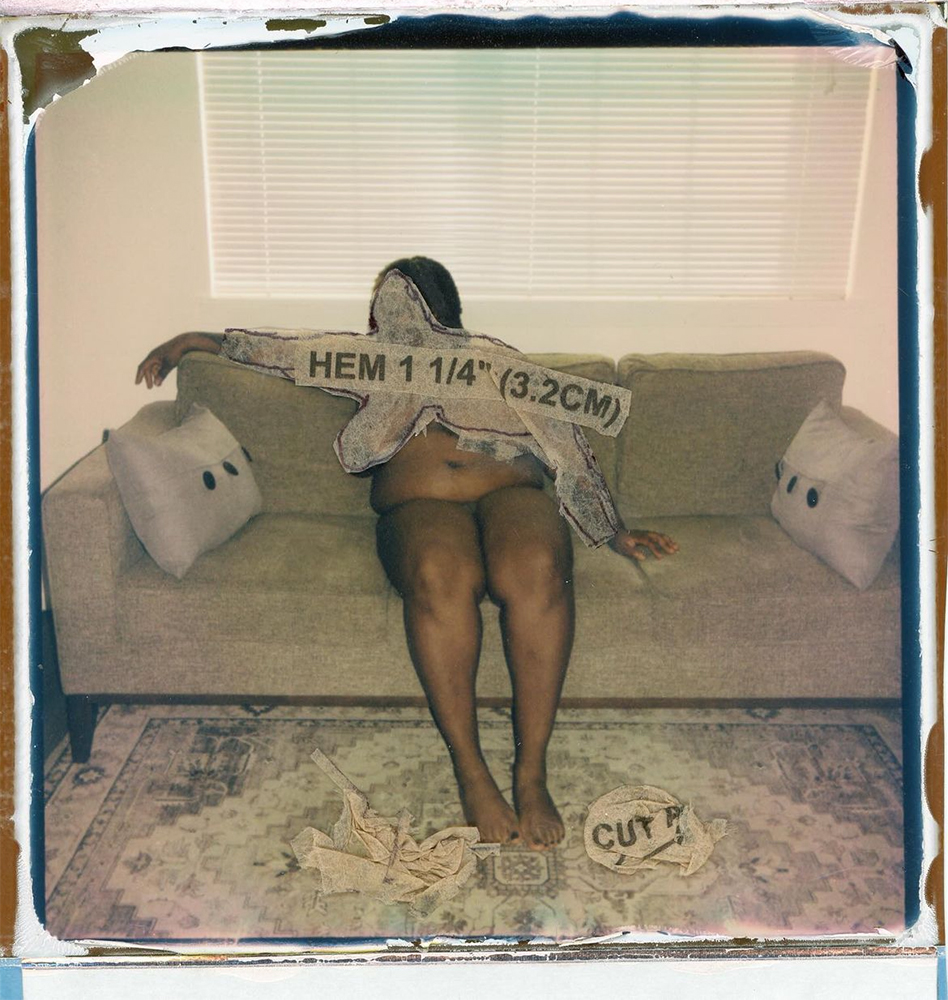
Image: Nakemiah sitting on a couch. She is nude and has one arm draped on the back of the couch and the other arm resting on the cushion. Covering her face, arms, and chest is pattern paper (used for sewing). There is text on the pattern paper “ Hem 1 ¼” (3.2 CM)” Some of the pattern paper is crumpled on the floor by her feet, There is one visible word “Cut.” The edges of the Polaroid film are distressed.
Megan: What are you working on now?
Nakemiah: In January, a colleague and fellow UH Alum named Cassie Ferguson and I will be in Hawaii for a week of artist residency in printmaking at UH Manoa with Professor Charlie Cohan. We will be creating collaborative prints under her home studio called Lost Bearings Press.
Also, while on island, I will be part of a beautiful exhibition with 14 other artists at Hō’ikeākea Gallery Exhibition on Leeward College campus curated by Mr. Phil called “Float On”. I’m just excited to get back to see everyone. I’ve been missing the art community in Hawaii and can’t wait for an opportunity to experience it again.
Megan: Do you have any advice for artists?
Nakemiah: Take your time and find out what works and speaks to you as a medium. I feel like when you have that connection with the medium, it allows you to tell your story in a way that you would never think is possible. Don’t be afraid to make mistakes. Don’t be afraid to step outside your box. Don’t allow anyone to put you in a box. Nobody can tell your story like you can.
Megan Bentis a lens-based artist interested in the ways image-making can happen beyond using a traditional camera. She is drawn to processes that reflect and embrace her disabled experience; especially interdependence, impermanence, care, and slowness. Her work has been exhibited domestically and abroad at venues including The U.N. Headquarters, NY, NY; Root Division, San Francisco, CA; form & concept, Santa Fe, NM; F1963, Busan, South Korea; and Fotonostrum, Barcelona, Spain. She was a recent recipient of the 2023 Wynn Newhouse Awards. Her work has been featured in Lenscratch, Analog Forever Magazine, Fraction Magazine, Too Tired Project, Rfotofolio, and Float Photography Magazine.
Posts on Lenscratch may not be reproduced without the permission of the Lenscratch staff and the photographer.
Recommended
-
Photographers on Photographers: Congyu Liu in Conversation with Vân-Nhi NguyễnDecember 8th, 2025
-
Linda Foard Roberts: LamentNovember 25th, 2025
-
Arnold Newman Prize: C. Rose Smith: Scenes of Self: Redressing PatriarchyNovember 24th, 2025
-
Spotlight on the Photographic Arts Council Los AngelesNovember 23rd, 2025
-
The Aline Smithson Next Generation Award: Emilene OrozcoNovember 21st, 2025

